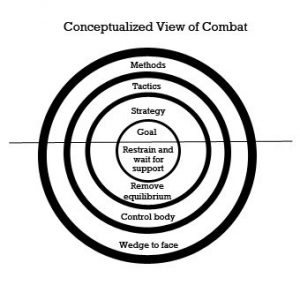Recently I read a post by an MMA instructor stating, ‘Why are people making things more difficult than they are? Punch someone in the face…a punch is a punch, a face is a face. It’s not all this biomechanics and thought. Don’t overcomplicate what you are doing.’
I chuckled, wondering how many times this instructor had competed and watched a fight tape of an opponent…or perhaps trained for a specific hold because he saw a weakness in an upcoming opponent.
We aren’t overcomplicating anything – we are looking for one thing: a head start. A short cut. Or, as some people say these days, a ‘hack.’
The above diagram is from our manual in combatives learning, CLM1: Efficient Perceptual Learning (which is undergoing an revision currently!) Available here: https://pramek.com/p-shop/product/clm-manual-1-efficient-perceptual-learning/
I often speak of combat being a machine, like a car. When your car breaks, you take it to a mechanic. The mechanic doesn’t look at the car, he looks at the systems within the car to find what to fix.
Looking at the diagram, we see the break down in how Pramek approaches combat – with a goal in mind. Not mindless swinging, not punch and a face – but a goal. We take the goal, develop a strategy to reach it, and then employ methods and tactics to achieve our goal. The idea being that if you know what you goal is, you can work toward that goal, position and control the fight to get there – while your opponent adapts to you.
By doing this, we create a head start in a fight. Would you take a head start if your life depended on it?
We gain extra time that we would have wasted figuring out, mid fight, what we want to accomplish. Combined with proper fight mechanics and biomechanical efficiency, proper experience, an understanding of science like physiology and psychology, we make the utmost of this extra time we have gained by deciding on our goal and working toward it.
We can adapt our weaknesses to this goal. In civilian combatives and martial art, rarely should you goal be to kill another person unless it’s legally justified. You have to pick an alternate goal…in the case of the above diagram, it’s to restrain the enemy and wait for assistance. This could happen in any number of situations – for example, you have witnessed someone injure another person, that aggressor then faces you, and you know the police have been called. If you are a weak striker, then you adapt your methods to not be striking. If you are a great striker, then you adapt your striking to get to your goal.
What you do not do is be uncontrolled, without a goal or a purpose – this can leave you open to your nervous system making decisions for you, absent thought and goal, and filled with adrenaline.
You gain focus.
The other part of this is the long term study of martial art. I recently had a friend tell me he was leaving his instructor – I asked why. He replied, ‘I learned all the techniques.’
There is so much more to martial art than the memorization of technique, which in this video we discuss why the number of techniques you learn in martial art becomes irrelevant in a fight.
When we break down martial art to it’s components, like biomechanics, or strategy, we begin to learn much more about what we are actually studying. In the CLM3 we talk about the reasons a student leaves studying with a teacher…and one of the primary reasons (instructors, pay attention) is the student, like my friend, feels they have learned all they can. Teacher and student should look at every area of what they are studying to create a life long learning lab within martial art – and in the rest of their lives.
Sure, a punch is a punch, but that punch will get boring eventually, and will come off too slow…it is better to learn more, and be faster…or that’s my opinion.
Conquer Yourself,
Matt
[su_divider]